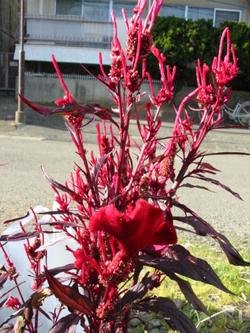
Celosia cristata
Crinkly cockscomb /C. cristata or keito (in Japanese) are common plants seen on house porches in summer especially with older folk. The colourful feathery kind C. plumosa are popular with the younger generation.
One fact that surprised me was that cockscomb have been around since the 1600s – I found this out when I read Linda Inoki’s article excerpted here for you below:
| Fukui was only six or seven miles away, so I set out after supper, walking uncertainly along the twilit road. Fukui is where Tosai has long lived as a recluse. I thought how old and decrepit Tosai would now be, or perhaps he was even dead. His shabby little house was buried in an out-of-the-way corner of the town. Moonflowers and bottle-gourds crept over the walls, and cockscomb and broom-grass grew so high they hid his door. “This must be the place,” I thought, and knocked on the gate. |
| From “The Narrow Road to Oku” by Matsuo Basho (1644-94), translated by Donald Keene (Kodansha International) |
These unusual fan-shaped flowers look like the brightly colored “comb” on top of a cockerel’s head, and so the names “keito” and “cockscomb” mean the same in both Japanese and English. However, some of these velvety flowers are so round and crinkled they look more like small brains. They are usually fiery shades of red, orange and gold, although some are bronze or even pale green. The two types of cockscomb most often grown in the garden are Celosia cristata (“crinkled celosia”) and C. plumosa (“feathery celosia”). In Britain, the latter is also called “Prince of Wales Feathers” as it resembles the gorgeous heraldic crest of the prince of Wales.
The Japan Times: Sept. 18, 2003
